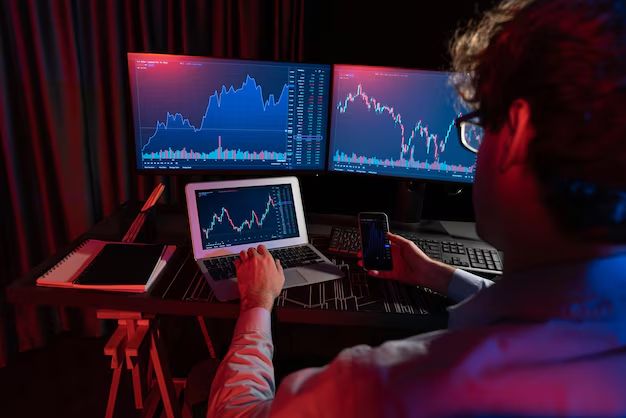Blog
Level Up Your Trading: Using Live Stock Data in Online Games

Gaming is evolving. Instead of just earning coins or points, players can now learn how financial markets work—through actual data. By connecting live stock prices with gameplay, developers are creating immersive and educational experiences. This shift combines entertainment with real-world knowledge, giving players new skills and perspectives.
“Gaming gives learners the ability to fail safely and learn quickly—a crucial trait for successful investors.” — Dr. Alan Morris, Behavioral Finance Researcher.
Why Integrating Live Stock Data in Games Matters
Blending real stock data with games creates an environment where strategy, emotion, and learning intersect. This is not just a trend; it is transforming how people understand finance in a natural, interactive way.
Realism and Engagement
Real-time data gives games an unpredictable, living quality. Every market movement impacts in-game performance, which keeps players alert and engaged. This realistic structure encourages strategic planning, similar to real investing.
How Real-Time Data Changes Gameplay
- Real events influence prices inside the game.
- Every player faces different scenarios.
- Timing and fast decision-making matter.
Emotional Investment in Virtual Markets
- Price swings create excitement and tension.
- Players experience emotional highs and lows.
- These feelings build risk tolerance and decision-making maturity.
Learning Through Play
When players interact with actual market dynamics, they absorb complex concepts through experience, not lectures. It’s active learning at its best, turning finance into a hands-on skill.
Active Learning vs. Passive Theory
- Players respond to changes rather than just read about them.
- Mistakes become lessons, not failures.
- Real-time cause and effect make concepts memorable.
Decision-Making Under Pressure
- Market fluctuations force fast reactions.
- Players learn the impact of hesitation or overconfidence.
- Analytical skills develop naturally.
Emotional and Analytical Growth
Finance is about psychology as much as it is about numbers. Live stock data helps players train both the mind and emotions, making them better decision-makers.
Building Emotional Resilience
- Experiencing gains and losses sharpens emotional control.
- Players learn to handle pressure calmly.
- Emotional stability leads to more intelligent choices.
Strengthening Analytical Skills
- Tracking charts and patterns builds fundamental skills.
- Players identify trends, not just numbers.
- Over time, strategy replaces impulse.
“Risk perception and emotional control are skills best learned through experience, not theory.” — Linda Hoang, Financial Psychologist.
Core System Design and Architecture
Behind every live-data trading game is an innovative structure. Real stock prices are pulled through APIs, scaled for the game economy, and displayed in a way that’s simple to understand.
How Live Stock Data Powers Gameplay

Integrating live data means converting complex financial information into simple, meaningful gameplay. It requires a solid technical base to keep information accurate and fast.
Key System Components
- Data feeds bring in real-time market updates.
- Game engines translate price changes to player portfolios.
- Clean interfaces make it easy to follow trends.
Handling Market Speed
- Slight delays help prevent unfair advantages.
- Scalability ensures all players get fair data.
- Alerts notify players of sudden changes.
Market Dynamics in Game Rules
Once the data arrives, the game’s internal rules determine how it affects players. Realism must be balanced with accessibility so beginners don’t get overwhelmed.
Trading and Timing Mechanics
- Players use virtual capital for all trades.
- Cooldowns and commissions mimic real conditions.
- Strategic timing becomes a skill.
Risk and Reward Balance
- Leverage and diversification options add depth.
- Players learn the consequences of overexposure.
- Simulated news shocks make decisions challenging.
Example: “Plants vs Brainrots Stock” Simulation
The Plants vs Brainrots Stock acts as a fictional example of how real market dynamics can power in-game trading. Its virtual price is directly tied to real-world data, creating opportunities for strategy, risk management, and market prediction.
Step-by-Step Simulation
- Real price = $150
- In-game price scaled = $15
- Real news affects real price
- In-game value changes instantly
- Players react—sell, hold, or buy
Strategic Player Response
- Some take profits early.
- Others hold for bigger gains.
- Some diversify for safety.
“This is where strategy meets reality. Players aren’t just pushing buttons—they’re managing portfolios under pressure.” — Jason Clark, Game Economist
Benefits and Educational Impact
Live-data trading games bridge entertainment and education. They make finance approachable, practical, and fun, offering benefits for both gamers and learners.
Skill Transfer to Real-World Investing
When players learn through real data, their skills can transfer to fundamental markets. What starts as a game often becomes practical knowledge.
Practical Investing Skills Gained
- Reading charts and identifying patterns.
- Understanding market behavior.
- Recognizing timing opportunities.
Long-Term Learning Benefits
- Improved economic awareness.
- Higher confidence in decision-making.
- Better risk understanding.
Safe Risk-Taking
In games, losses don’t hurt financially. This makes it the perfect space to experiment, fail, and grow without real consequences.
Learning Through Failure
- Mistakes are part of the process.
- Players gain wisdom with no real loss.
- Repeated trials strengthen the strategy.
Experimenting with Strategies
- Try long-term vs short-term plays.
- Compare aggressive vs defensive tactics.
- Understand how emotions influence actions.
Economic Awareness
Over time, players naturally learn how global events shape markets. This builds a practical understanding of economics without the need for formal training.
Understanding Cause and Effect
- News influences prices directly.
- Policy changes affect industries.
- Players connect headlines to outcomes.
Observing Market Patterns
- Players recognize recurring trends.
- Sector-wide changes become easier to follow.
- Economic principles are learned by doing.
“Gamified investing can do what textbooks cannot: teach economics as a living, breathing system.” — Professor Mark Ingram, Economic Historian.
Challenges, Risks, and Solutions
While powerful, this system also faces technical, legal, and psychological challenges. Addressing them ensures fair play and a healthy learning environment.
Technical Challenges
Live data systems need a reliable infrastructure to deliver accurate information to all players at the same time.
Common Technical Barriers
- Data latency reduces realism.
- Server overload can disrupt play.
- Security must prevent manipulation.
Possible Solutions
- Use stable, scalable data sources.
- Build backup systems.
- Implement anti-bot protections.
Legal and Ethical Concerns
Since real data is used, developers must navigate regulations to keep the game legal and transparent.
Licensing and Data Usage
- Some data sources have strict rules.
- Licensing agreements may be required.
- Transparency builds player trust.
Gambling and Financial Rules
- Real money tournaments may be regulated.
- Clear disclaimers protect developers.
- Educational intent must be maintained.
Psychological Risks
Trading—real or simulated—can be emotionally intense. Games must protect players from unhealthy engagement.
Emotional Pressure in Simulations
- Realistic volatility can stress players.
- Losing streaks affect motivation.
- Addiction risk exists with constant updates.
Healthy Engagement Strategies
- Include time reminders.
- Limit trading frequency.
- Emphasize learning over winning.
Real-World Examples of Data-Driven Games
Several platforms already use real market data to teach or entertain. These examples show how financial literacy and gameplay can work together.
Stock Market Simulators
Simulators use real-time data to replicate real trading environments without financial risk.
Common Simulator Features
- Virtual portfolios and leaderboards.
- Real-time stock price integration.
- Educational modules for beginners.
Benefits for Learners
- Safe practice environment.
- Immediate feedback on strategies.
- Scalable for individuals or classrooms.
Gamified Financial Learning Apps
Financial learning apps transform complex topics into simple, interactive experiences suitable for students and beginners.
Learning Through Interaction
- Mini-games explain significant concepts.
- Achievements keep players motivated.
- Challenges promote consistency.
Ideal for Early Financial Education
- Great for schools and beginners.
- Encourages daily engagement.
- Bridges theory and real practice.
Traditional Games That Inspired This Trend
Before digital trading platforms, board and early computer games used market mechanics to teach players about economics.
Classic Market Simulation Games
- Stock trading board games.
- Vintage computer trading simulators.
- Early financial competitions.
Lessons from the Past
- Simplicity is key to understanding.
- Strategy grows with repetition.
- Real data adds a new layer of realism.
“Even before APIs existed, developers knew finance and gameplay were a natural match.” — Henry Lau, Game Design Historian.
How to Build a Live-Data Trading Game

Developing a trading game involves balancing realism, accessibility, and engagement. A structured approach ensures smooth development and substantial educational value.
Start Simple
Developers should launch with limited features and expand gradually as the platform grows.
First Steps
- Choose a small stock universe.
- Build a clean and straightforward interface.
- Introduce only essential mechanics.
Gradual Expansion
- Add more assets over time.
- Introduce complexity as players learn.
- Keep the learning curve smooth.
Balance Fun and Realism
Games should feel authentic without overwhelming players. A small dose of realism can make the difference between fun and frustration.
Key Balancing Tactics
- Introduce small trading fees.
- Add cooldowns to mimic market pace.
- Simulate news events.
Designing Accessible Interfaces
- Use clear charts and simple menus.
- Provide optional tutorials.
- Offer beginner and expert modes.
Make It Social
Community features turn trading into a shared experience that boosts engagement and learning.
Competitive Features
- Leaderboards and tournaments.
- Achievement badges.
- Weekly challenges.
Collaborative Learning
- Player groups or teams.
- Strategy sharing.
- Replay analysis.
Respect the Law
Compliance protects both players and developers. Legal clarity maintains the game’s integrity.
Legal Considerations
- Data usage and licensing.
- Clear disclaimers.
- User protection rules.
Ethical Game Design
- Avoid exploitative mechanics.
- Keep education central.
- Protect player well-being.
“The best educational games respect real-world rules while creating safe spaces to learn them.” — Sarah Reid, Compliance Consultant
Practical Tips for Players
Players can get the most from live-data trading games by approaching them strategically—not just playfully.
Start Conservatively
Early Game Habits
- Begin with stable stocks.
- Use small amounts of capital.
- Focus on learning, not winning.
Avoiding Common Mistakes
- Don’t chase fast gains.
- Avoid over-trading.
- Learn before using leverage.
Reflect on Every Trade
Tracking Performance
- Keep a simple trade journal.
- Note reasons for each decision.
- Review both wins and losses.
Improving Over Time
- Identify patterns in behavior.
- Adjust strategies slowly.
- Celebrate progress, not perfection.
Manage Emotions
Staying Calm
- Expect losses as part of the game.
- Don’t trade impulsively.
- Take breaks during volatility.
Psychological Strength
- Emotional control improves decision-making.
- Balanced thinking leads to consistent results.
- Confidence grows with practice.
Learn From Others
Observing Skilled Players
- Watch the strategies of top performers.
- Understand their reasoning.
- Adapt ideas to your style.
Building a Community
- Join discussions.
- Share your own insights.
- Learn collaboratively.
Future of Data-Driven Gaming
As technology evolves, live-data trading games will become even more powerful and widely used. They’ll combine education, competition, and financial awareness in new ways.
Prize Competitions and Tournaments
Competitive Evolution
- Regulated prize pools may emerge.
- Leaderboards will drive higher engagement.
- Top performers can gain recognition.
Blockchain and Tokenization
Expanding Ownership
- Players may own tokenized assets.
- Virtual portfolios could have real value.
- Secure transactions increase trust.
AI Opponents and Personalized Learning
Intelligent Competition
- AI traders can challenge players.
- Difficulty adjusts to player skill.
- Personalized lessons enhance learning.
Mainstream Education Adoption
Education Revolution
- Schools may integrate these games into finance courses.
- Financial literacy can be taught through play.
- A generation of market-aware learners can emerge.
“When the stock market becomes a game, the classroom expands beyond walls.” — Dr. Elena Garcia, Education Futurist.
References and Suggested Reading
- The Psychology of Money — Morgan Housel
- Thinking, Fast and Slow — Daniel Kahneman
- A Random Walk Down Wall Street — Burton Malkiel
- Behavioral Finance: Understanding the Social, Cognitive, and Economic Debates — Edwin Burton
- Gamification and Education — Karl M. Kapp
- Journal articles on financial literacy, gamification, and behavioral finance
- Expert commentary from behavioral economists, financial educators, and game designers.
Disclaimer
The information presented in this article, including references to Plants vs Brainrots Stock and other fictional or real financial instruments, is intended for educational and entertainment purposes only.
It does not constitute financial, investment, or legal advice. Trading in financial markets involves risks, including the loss of principal.
Readers should not rely solely on game-based experiences when making actual investment decisions. Always conduct your own research or consult with a licensed financial advisor before engaging in real-world trading or investing.
All examples, scenarios, and stock names used within this article are either fictional or illustrative and should not be interpreted as investment recommendations. The developers, authors, and publishers of this content are not liable for any losses incurred from investment or trading activities.
